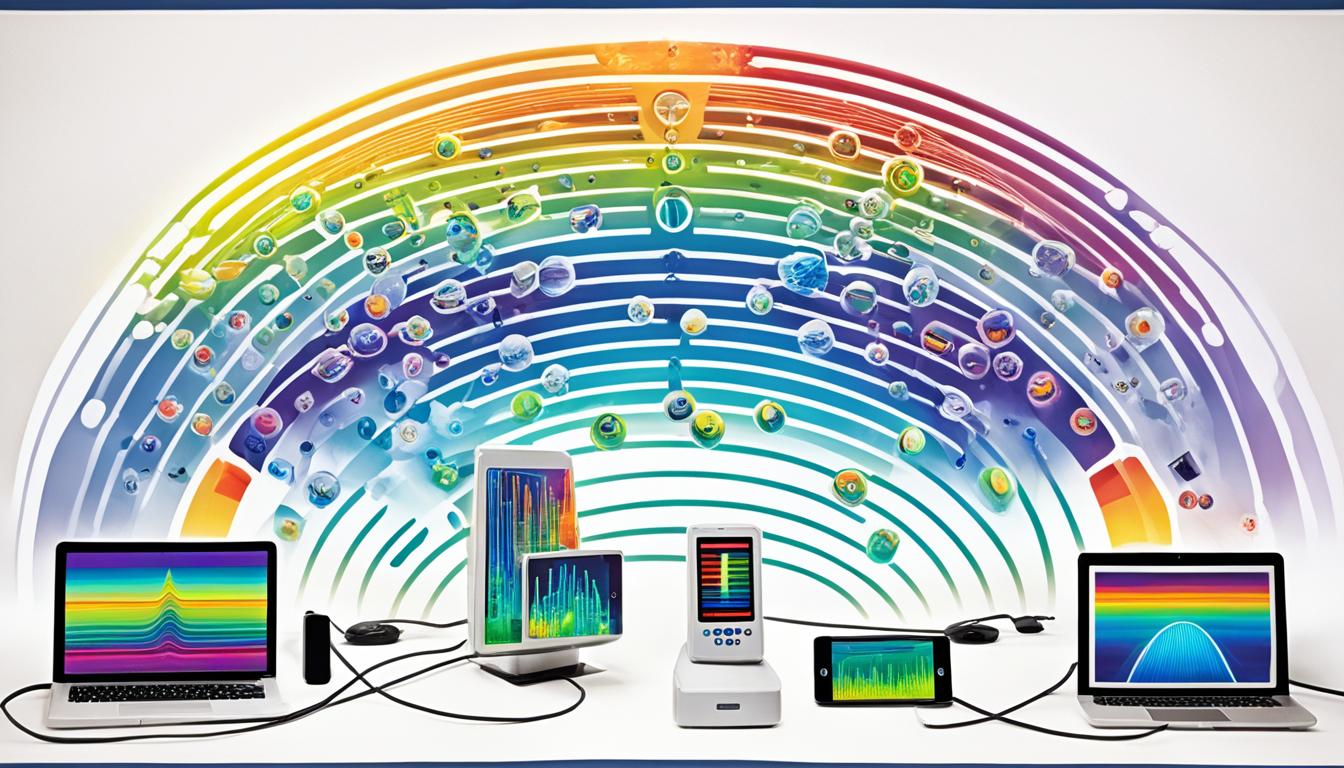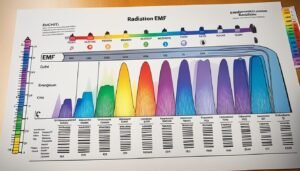Disclosure: This Post Contains Affiliate Links; We earn a commission on purchases.
Electric and magnetic fields (EMFs) are invisible areas of energy associated with electrical power and various forms of lighting. Understanding the different types of EMFs is crucial in assessing potential health risks and taking necessary precautions.
EMFs can be categorized into non-ionizing (low-level) and ionizing (high-level) radiation. Non-ionizing EMFs, such as extremely low-frequency (ELF) radiation and radiofrequency (RF) radiation, are generally considered harmless to humans. On the other hand, ionizing EMFs, like ultraviolet (UV) radiation and X-rays, have the potential to cause cellular and DNA damage.
While there has been some concern about the possible link between EMF exposure and childhood leukemia, studies have not provided conclusive evidence of a connection to adult cancers. That said, the effects of EMF exposure from modern devices such as cell phones, wireless routers, and smart meters are still being researched.
To gain a deeper understanding of the range of EMFs and their potential impact on human health, let’s explore the different types of electromagnetic radiation and their characteristics.
Key Takeaways:
- EMFs can be divided into non-ionizing and ionizing radiation.
- Non-ionizing EMFs, such as ELF radiation and RF radiation, are generally considered harmless.
- Ionizing EMFs, including UV radiation and X-rays, have the potential for cellular and DNA damage.
- There is no conclusive evidence linking EMF exposure to adult cancers.
- Research is ongoing to understand the impact of EMF exposure from modern devices.
Non-Ionizing EMFs: Understanding the Low-Level Radiation
Non-ionizing EMFs encompass a range of radiation types, including extremely low-frequency (ELF) radiation, radiofrequency (RF) radiation, microwaves, and visual light. These forms of electromagnetic radiation are generally perceived as harmless to human health.
ELF radiation is commonly emitted by power lines, electrical appliances, and household energy smart meters. RF radiation, on the other hand, is emitted by ubiquitous wireless devices such as cell phones, Bluetooth devices, and Wi-Fi networks.
While there have been some studies suggesting a weak association between the strength of EMF fields and an increased risk for childhood leukemia, the evidence remains limited and inconclusive. However, it is important to note that extensive research on adults has revealed no evidence of a link between EMF exposure and adult cancers such as leukemia, brain cancer, and breast cancer.
It is worth exploring the different types of non-ionizing EMFs and their characteristics:
- ELF Radiation: Commonly emitted by power lines, electrical appliances, and household energy smart meters.
- RF Radiation: Emitted by wireless devices like cell phones, Bluetooth devices, and Wi-Fi networks.
- Microwaves: Used primarily for cooking or heating food.
- Visual Light: The portion of the electromagnetic spectrum that is visible to the human eye.
| Type of EMF | Common Sources |
|---|---|
| ELF Radiation | Power lines, electrical appliances, household energy smart meters |
| RF Radiation | Cell phones, Bluetooth devices, Wi-Fi networks |
| Microwaves | Microwave ovens |
| Visual Light | Natural and artificial light sources |
While concerns about non-ionizing EMF exposure and cancer risk persist, the prevailing scientific consensus suggests that the low-level radiation emitted by these sources does not pose a significant threat. However, further research is necessary to fully understand the long-term effects of non-ionizing EMFs on human health.
Distinguishing Non-Ionizing EMFs from Ionizing EMFs:
“Non-ionizing EMFs, such as ELF radiation and RF radiation, are generally considered safe for human health. Ionizing EMFs, in contrast, have the potential to cause cellular and DNA damage.”
Ionizing EMFs: Understanding the High-Level Radiation
Ionizing EMFs pose a greater risk of cellular and DNA damage compared to non-ionizing EMFs. This category includes UV radiation, X-rays, and gamma rays, which are known to have high energy levels capable of directly breaking DNA bonds. UV radiation is primarily derived from sunlight, while X-rays and gamma rays are commonly used in medical imaging procedures.
UV radiation, despite being abundant in sunlight, is a known cause of skin damage and can increase the risk of skin cancer. It is crucial to protect oneself from excessive exposure to UV radiation by using sunscreen, wearing protective clothing, and seeking shade during peak sunlight hours.
X-rays and gamma rays, on the other hand, are widely used in medical settings for diagnostic purposes. These high-energy radiations can help detect fractures, tumors, and other medical conditions. However, their potential for cellular and DNA damage requires strict control and limited exposure to ensure patient safety.

It is important to note that while ionizing EMFs have the potential for harm, the risk of adverse health effects from everyday exposure is generally low. Medical professionals and regulatory agencies closely monitor and regulate the use of these types of radiation to ensure the safety of both patients and healthcare providers.
Potential Health Effects of EMF Exposure
While the majority of the population is not adversely affected by EMF exposure, some individuals may experience sensitivity known as electro hypersensitivity (EHS). EHS can result in various symptoms such as headaches, trouble concentrating, anxiety, tingling in the skin and face, and disrupted sleep.
Studies have shown that EMFs can interfere with cellular processes and potentially cause DNA damage. This disruption at the cellular level raises concerns about the potential health effects of EMF exposure.
Neurological illnesses, such as depression and anxiety, are among the potential consequences of EMF exposure. The interference with cellular processes can affect the central nervous system, leading to mental health issues in susceptible individuals.
Cardiac complications, including high blood pressure, have also been associated with EMF exposure. The impact on the cardiovascular system may disrupt the normal functioning of the heart, potentially leading to adverse cardiac events.
EMFs can also have detrimental effects on vision, with vision impairment being a potential health consequence. The sensitive structures of the eye may be susceptible to damage from prolonged and excessive exposure to EMFs.
Furthermore, there is emerging evidence suggesting a link between EMF exposure and auto-immune issues. The disruption of cellular processes and potential DNA damage may trigger abnormal immune responses, leading to auto-immune disorders.
It is important to note that the evidence connecting EMF exposure to these health effects is still limited and not yet definitive. While some studies have shown associations, more research is needed to fully understand the extent of the risks and establish clear guidelines for safe exposure levels.

Despite the current limitations in scientific understanding, it is prudent to take precautionary measures to minimize EMF exposure, especially for individuals who experience symptoms of electro hypersensitivity (EHS) or have heightened concerns about the potential health risks. Limiting the use of wireless devices, reducing proximity to EMF-emitting sources, and creating low-EMF environments can help lessen exposure levels. Additionally, addressing underlying health conditions and practicing stress management techniques may provide some relief for individuals experiencing EHS symptoms.
Limiting EMF Exposure
Reducing exposure to electromagnetic field (EMF) radiation is essential for maintaining a healthy lifestyle. By implementing simple practices and making conscious choices, individuals can significantly minimize their exposure to various types of EMFs. Here are some effective ways to limit EMF radiation:
1. Reduce RF Exposure:
Radiofrequency (RF) radiation, emitted by wireless devices, is a common source of EMF radiation. To reduce RF exposure:
- Turn off the Wi-Fi signal on routers or consider using a router without Wi-Fi functionality.
- Use speakerphone or corded headphones instead of holding cell phones close to the head.
- Limit the use of wireless devices, laptops, and tablets, especially in close proximity to the body.
2. Minimize Electrical Field Exposure:
Electrical fields are generated by household appliances, power lines, and electrical wiring. To minimize electrical field exposure:
- Consider shutting off power to the bedroom at night using electrical switches or control boxes.
- Use shielded cables and connectors to minimize the electric field emitted by electronic devices.
- Install filters or suppressors to reduce electromagnetic interference and prevent “dirty power”.
3. Create a Safe Sleeping Environment:
During sleep, it is essential to create a safe and low-EMF environment for optimal rest and recovery:
- Place electronic devices such as cell phones, tablets, and laptops away from the bed.
- Use a battery-powered alarm clock rather than an electric one.
- Consider using shielding fabrics or canopies to protect against external EMF sources.
Remember, every individual’s sensitivity to EMF radiation can vary, and the significance of EMF exposure may depend on personal circumstances and lifestyle choices. By implementing these practices, individuals can take control of their EMF exposure and minimize potential health risks.
| Types of EMF Exposure | Methods to Limit Exposure |
|---|---|
| RF Radiation | Turn off Wi-Fi signal on routers Use speakerphone or corded headphones Limit wireless device usage |
| Electrical Fields | Shut off power to bedrooms at night Use shielded cables and connectors Install filters for electronics |
| During Sleep | Keep electronic devices away from the bed Use battery-powered alarm clocks Consider using shielding fabrics or canopies |
Conclusion
In conclusion, it is crucial to understand the different types of electromagnetic fields (EMFs) and their potential health effects in order to make informed decisions about limiting exposure. EMFs can be categorized into non-ionizing and ionizing radiation, each with its own characteristics and risks.
Non-ionizing EMFs, such as extremely low-frequency (ELF) radiation and radiofrequency (RF) radiation, are generally considered harmless. They are emitted by various sources like power lines, household appliances, and wireless devices. On the other hand, ionizing EMFs, including ultraviolet (UV) radiation and X-rays, have the potential to cause cellular and DNA damage.
Although studies suggest a possible weak link between EMF exposure and childhood leukemia, there is no conclusive evidence of a connection to adult cancers. However, concerns persist about the potential health effects of EMF exposure from modern devices. Therefore, further research is essential to fully understand the impact of EMFs on human health and to establish clear guidelines for safe exposure levels.
In summary, by gaining a comprehensive understanding of EMFs, individuals can make informed choices to limit their exposure and minimize potential risks. Continued research is necessary to delve deeper into the effects of EMF exposure on human health, ensuring the development of effective safety measures and guidelines.
Source Links
- https://www.niehs.nih.gov/health/topics/agents/emf
- https://www.sdge.com/sites/default/files/final_emf_s1510006_eng.pdf
- https://passionelectric.com/understanding-emfs/

Subscribe to Our Newsletter










